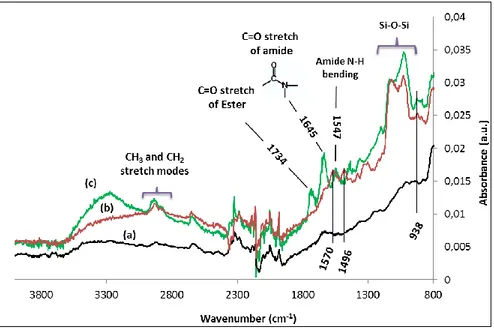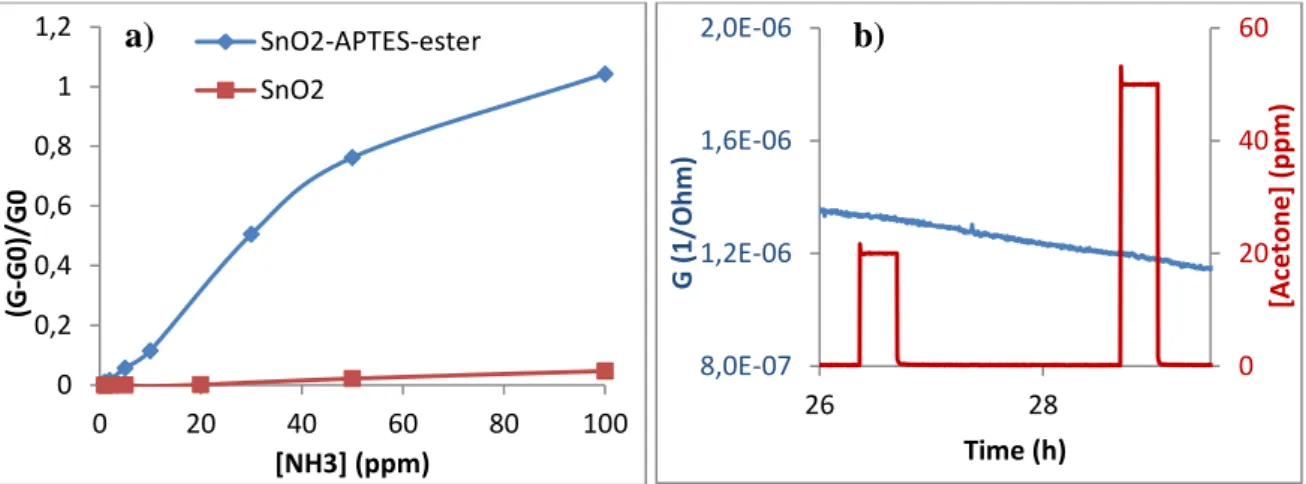HAL Id: hal-01436032
https://hal.archives-ouvertes.fr/hal-01436032
Submitted on 16 Jan 2017
HAL is a multi-disciplinary open access
archive for the deposit and dissemination of
sci-entific research documents, whether they are
pub-lished or not. The documents may come from
teaching and research institutions in France or
abroad, or from public or private research centers.
L’archive ouverte pluridisciplinaire HAL, est
destinée au dépôt et à la diffusion de documents
scientifiques de niveau recherche, publiés ou non,
émanant des établissements d’enseignement et de
recherche français ou étrangers, des laboratoires
publics ou privés.
Modification
Mohamad Hijazi, Mathilde Rieu, Valérie Stambouli, Guy Tournier, Jean-Paul
Viricelle, Christophe Pijolat
To cite this version:
Mohamad Hijazi, Mathilde Rieu, Valérie Stambouli, Guy Tournier, Jean-Paul Viricelle, et al.. Selective
Ammonia Gas Sensor based on SnO2-APTES Modification. 30th anniversary Eurosensors Conference
(EUROSENSORS 2016), Hungarian Academy of Sciences; Akadémiai Kiadó / AKCongress, Sep 2016,
Budapest, Hungary. pp.280-283, �10.1016/j.proeng.2016.11.193�. �hal-01436032�
30th Eurosensors Conference, EUROSENSORS 2016
Selective ammonia gas sensor based on SnO
2
-APTES
modification
M. Hijazi
1, M. Rieu
11, V. Stambouli
2, G. Tournier
1, J-P. Viricelle
1, C. Pijolat
11Ecole Nationale Supérieure des Mines, SPIN-EMSE, CNRS:UMR5307, LGF, 42023 Saint-Etienne, France 2 LMGP, Université Grenoble-Alpes, Grenoble INP-MINATEC, CS 50257, 38016 Grenoble Cedex 1, France
Abstract
In the present work, SnO2 sensors were produced by thick film fabrication. In order to deal with well-known
lack of selectivity of SnO2 sensors, functionalization was performed. Silanization by 3-aminopropyltriethoxysilane (APTES) in liquid phase was used as an intermediate step, followed by
functionalization with molecules bearing acyl chloride with different end functional groups molecules, for example ester group. Modified sensors with APTES and ester end functional group were successfully characterized by attenuated total reflectance-Fourier transform infrared spectroscopy (ATR-FTIR). The SnO2 sensor modified with ester end group was found to be sensitive and selective to ammonia gas at 100°C. Working at low temperature is also one of the advantages of these sensors as well as the selectivity with respect to other gases like acetone.
Keywords: SnO2; surface functionalization; APTES; gas sensors; selectivity; NH3; acetone
1. Introduction
Molecularly modified metal oxide gas sensors have shown to be promising devices for selective gas sensor related to disease diagnosis [1]. Those sensors can be used to detect the gas emanated from the human body for breath analysis application. Tin dioxide sensors have lack of selectivity and work at high temperature (350-500°C). The need of selective sensors with high sensitivity in presence of humidity at low gases concentration pushes the research to modify SnO2 sensing element in order to change its interactions with gas. The modification with organic functional groups with different polarities change the sensor response to specific gases depending on their polarity [2]. A functionalization based on 3-aminopropyltriethoxysilane (APTES) combined with methyl adipoyl
* Corresponding author. Tel.: +33 4 77 42 02 82.
chloride was investigated. Another objective is to reduce the power consumption by decreasing the operating temperature.
In the present work we focus on the change in selectivity and sensitivity of SnO2 sensors after functionalization with ester end functional group film. The sensors were firstly functionalized by APTES followed by covalent attachment of ester end functional group molecule. Functionalization was characterized with FTIR analysis. Then, detection performances of resulting sensors were investigated in regards of ammonia detection.
2. Experimental
SnO2 thick films are deposited on alumina substrate by screen-printing technology. In this survey, a semi-automatic Aurel C890 machine was used; the procedure for preparing the SnO2 ink and sensor fabrication parameters has been described elsewhere [3]. The SnO2 powder (Prolabo Company) is first mixed with a solvent and an organic binder. An oxide film with a thickness of 40 microns is then deposited on an alpha-alumina substrate (38×5×0.4 mm3) provided on one face with a screen-printed platinum heater and on the other face with two gold electrodes deposited by reactive sputtering. The SnO2 material is finally annealed for 10 hours at 700°C in air. The SnO2 particles sizes were found to be between 10 nm and 500 nm.
The functionalization of SnO2 sensor leads to covalent attachment of ester end functional groups. Hydroxyl groups present on the surface of SnO2 allow the condensation of 3-aminopropyltriethoxysilane (ACROS Organics). The terminal amine groups of APTES allow the coupling reaction with molecules bearing acyl chloride group. Silanization in liquid phase has been described elsewhere [4]. In a first step, SnO2 sensors were immersed in 50 mM APTES dissolved in 95 % absolute ethanol and 5 % of deionized water for 5 hours under stirring at room temperature. To remove the unbounded APTES molecules, the sensors were rinsed with absolute ethanol and dried under N2 flow. In a second step, for ester end group grafting, APTES modified SnO2 sensors were immersed in a solution of 10 mM of methyl adipoyl chloride (96 %, Alfa Aesar) and 5 µL of triethylamine (Fluka) in 5 mL of chloroform as solvent for 17 hours under stirring. The sensors were then rinsed with chloroform and dried under N2 flow.
Modified molecular layers were characterized by attenuated total reflectance-Fourier transform infrared spectroscopy (ATR-FTIR), the sample being placed face-down on the diamond crystal, and a force being applied by pressure tip. FTIR spectra were recorded in a wavelength range from 400 to 4000 cm-1. The scanning resolution was 2 cm-1. The entire ATR-FTIR spectrums were collected using a Golden Gate Diamond ATR accessory (Bruker Vertex 70).
3. Results and Discussions
Figure 1 shows the ATR-FTIR spectra of SnO2 film (a) after functionalization by APTES (b) and APTES-ester (c). The most significant absorption bands are found between 800 and 1800 cm-1 for functionalized SnO2. The peak at 938 cm1 is attributed to Sn-O-Si bond in stretching mode [5]. The wide band between 978 cm-1 and 1178 cm-1 is attributed to siloxane groups (Si-O-Si) from polymerized APTES. The -NH2 and -NH3+ vibrational signals found at 1570 cm-1 and 1496 cm-1 (figure 1b) respectively, confirms the presence of amine end functional group of APTES after silanization. These two peaks disappeared and two another appear at 1547 cm-1 and 1645 cm-1 (figure 1c) after ester modification which correspond to carbonyl stretch mode and N-H bending mode of amide respectively. Additional broad peak between ~ 3000 and ~ 3600 cm-1 correspond to N-H stretch of amide. The stretching peak of carbon double bounded to oxygen of ester group is found at 1734 cm-1. The zone between ~1950 and 2380 cm-1 is not exploitable; it corresponds to CO2 gas in ambient air. As a conclusion, FTIR analysis allows to confirm that functionalization was successfully achieved on SnO2 films.
Fig. 1. ATR-FTIR spectra of SnO2 (a), SnO2-APTES (b), and SnO2-APTES-ester (c) films.
Resulting sensors performances were investigated in a test bench allowing to generate various NH3 concentrations, but also acetone with controlled humidity. Figure 2 shows the response (conductance variation) of SnO2-APTES-ester sensor compared to pure SnO2 sensor at 100°C under humid air (26 % of relative humidity) upon exposure to NH3 gas. The ester modified sensor gives increase in conductance to NH3, while no significant response for the non-modified sensor with noisy base line is observed. Figure 3a, shows the relative responses versus NH3 concentration and points out a nearly constant sensitivity of ester modified sensor in the range 0-50 ppm. Relative response is defined as (G-G0/G0), where G0 is the base line conductivity under air and G is the conductivity after 20 minutes of gas injection (NH3). Sensitivity at ppb level has to be investigated. Concerning selectivity, figure 3b demonstrates that the SnO2-APTES-ester sensor doesn't have any response to acetone (0-50 ppm) that could interfere in the detection of NH3 gas. Regarding detection mechanism, assembled polar molecules on a surface of metal oxide semiconductor surface can form a dipole layer, which can create a depletion layer on metal oxide surface and adjusts the work function of semiconductor [6]. The ester end group (COOCH3) is electron withdrawing group. The positive pole of NH3 molecule, near the molecular layer surface, generates changes in the layer’s dipole moment, which implies modifications in the conductance of the whole film.
Fig. 2. Response of SnO2-APTES-Ester and SnO2 sensor upon exposure to NH3 gas in air containing 26 % of relative humidity at 20 °C. The
Fig. 3. a) Relative response of SnO2-APTES-Ester and SnO2 sensors versus NH3 concentrations; b) Response of SnO2-APTES-Ester sensor
upon exposure to acetone gas. The sensors operating temperature is 100 °C, in air containing 26 % of relative humidity at 20 °C.
4. Conclusion
SnO2 thick films produced by screen printing were successfully functionalized. The modifications were done by attachement of APTES on SnO2 film followed by coupling reaction with acyl chloride molecules having ester end functional group. Modified films were characterized by ATR-FTIR. Ester modified sensor was found to be sensitive and selective to NH3 gas at 100 °C in humid air. The selectivity was tested with respect to acetone gas. Sensors performances at ppb level have to be examined as well as the detailed sensing mechanism.
References
[1] N. Shehada, G. Brönstrup, K. Funka, S. Christiansen, M. Leja, H. Haick, Nano Letters 15 (2015) 1288–1295. [2] B. Wang, H. Haick, ACS Applied Materials & Interfaces 5 (2013) 2289–2299.
[3] G. Tournier, C. Pijolat, Sensors and Actuators B: Chemical 106 (2005) 553–562. [4] M. Le, C. Jimenez, E. Chainet, V. Stambouli, Sensors 15 (2015) 10686–10704.
[5] I. Matsubara, K. Hosono, N. Murayama, W. Shin, N. Izu, Sensors and Actuators B: Chemical 108 (2005) 143–147.
[6] T. He, J. He, M. Lu, B. Chen, H. Pang, W.F. Reus, W.M. Nolte, D.P. Nackashi, P.D. Franzon, J.M. Tour, Journal of the American Chemical Society 128 (2006) 14537–14541. 0 0,2 0,4 0,6 0,8 1 1,2 0 20 40 60 80 100 (G -G0)/ G0 [NH3] (ppm) SnO2-APTES-ester SnO2

